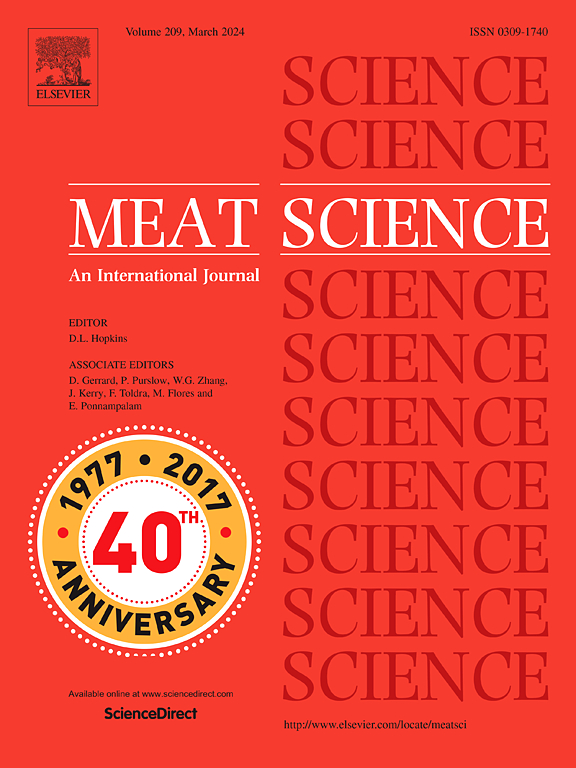Dietary hazelnut skin prevents lipid oxidation in lamb enriched in omega-3 polyunsaturated fatty acids
IF 6.1
1区 农林科学
Q1 Agricultural and Biological Sciences
引用次数: 0
Abstract
The aim of this study was to investigate the effect of partially replacing maize with hazelnut skin and linseed, alone or in combination, on the oxidative stability of lamb. Forty lambs were randomly assigned to 4 treatments and fed: a conventional cereal-based diet (C), or the same diet with 15 % of hazelnut skin (HS), or 8 % of extruded linseed (LS), or 7.5 % of hazelnut skin plus 4 % of linseed (H + L) as partial replacement of maize. After 60 days of feeding trial, lambs were slaughtered, and hydrophilic antioxidant capacity and fat-soluble vitamins content were evaluated in fresh meat. Colour stability, lipid and protein oxidation were assessed during 7 days of refrigerated storage. Dietary combination of hazelnut skin and linseed increased the content of tocopherols (P < 0.001) and of n-3 polyunsaturated fatty acids (PUFA n-3; P < 0.001), while reducing lipid oxidation (TBARS value) during 7 days of storage (P < 0.001). Feeding lamb with hazelnut skin and/or linseed did not affect meat hydrophilic antioxidant capacity, colour stability, nor the formation of hydroperoxides, thiols, or carbonyls (P > 0.05). These results suggest that vitamin E provided by hazelnut skin contributed to delay lipid oxidation in meat, despite the higher concentration of n-3 PUFA.
膳食榛子皮可以防止富含omega-3多不饱和脂肪酸的羊肉脂质氧化
本研究的目的是研究榛子皮和亚麻籽单独或组合部分替代玉米对羔羊氧化稳定性的影响。选取40只羔羊,随机分为4个处理,分别饲喂常规谷物为主饲粮(C)、添加15%榛子皮(HS)、8%挤压亚麻籽(LS)或7.5%榛子皮加4%亚麻籽(H + L)部分替代玉米的相同饲粮。饲喂试验60 d后,屠宰羔羊,评价其鲜肉中亲水抗氧化能力和脂溶性维生素含量。在7天的冷藏中评估颜色稳定性、脂质和蛋白质氧化。饲粮中添加榛子皮和亚麻籽可提高生育酚含量(P <;0.001)和n-3多不饱和脂肪酸(PUFA n-3;P & lt;0.001),同时在7天的储存期间降低脂质氧化(TBARS值)(P <;0.001)。用榛子皮和/或亚麻籽喂养羔羊不会影响肉的亲水抗氧化能力、颜色稳定性,也不会影响氢过氧化物、硫醇或羰基的形成(P >;0.05)。这些结果表明,尽管榛子皮中的n-3 PUFA浓度较高,但其提供的维生素E有助于延缓肉中的脂质氧化。
本文章由计算机程序翻译,如有差异,请以英文原文为准。
求助全文
约1分钟内获得全文
求助全文
来源期刊

Meat Science
工程技术-食品科技
CiteScore
12.60
自引率
9.90%
发文量
282
审稿时长
60 days
期刊介绍:
The aim of Meat Science is to serve as a suitable platform for the dissemination of interdisciplinary and international knowledge on all factors influencing the properties of meat. While the journal primarily focuses on the flesh of mammals, contributions related to poultry will be considered if they enhance the overall understanding of the relationship between muscle nature and meat quality post mortem. Additionally, papers on large birds (e.g., emus, ostriches) as well as wild-captured mammals and crocodiles will be welcomed.
 求助内容:
求助内容: 应助结果提醒方式:
应助结果提醒方式:


